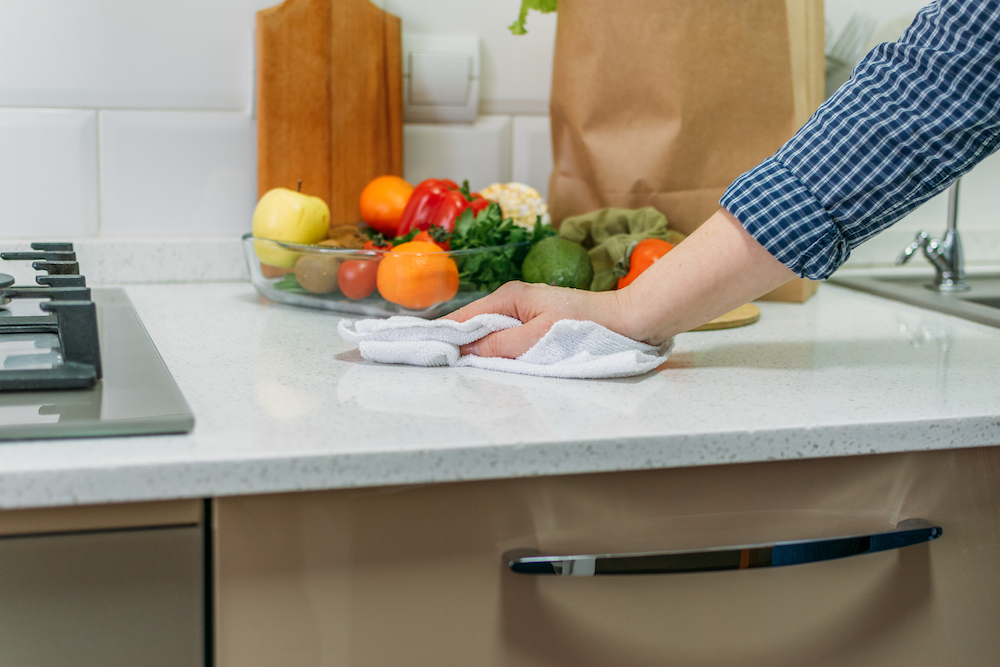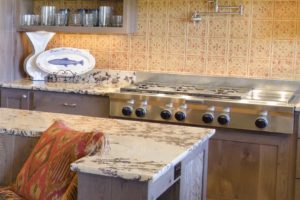When and How to Reseal Stone Countertops

Stone countertops are prized for their beauty, durability, and timeless appeal. However, even the toughest stone needs a little help to stay in peak condition. That’s where sealing comes in. Properly sealed countertops resist stains, moisture, and everyday wear, keeping them looking great for years. But how do you know when it’s time to reseal your countertops? And what’s the right way to do it?
In this guide, we’ll explore the science behind sealing stone countertops, how to test your seal, and a step-by-step process for resealing when necessary.
Why Sealing Matters for Stone Countertops
Natural stone, such as granite, marble, and limestone, is porous. That means liquids and oils can seep into the surface if it’s not properly sealed, leading to stains, discoloration, and even structural damage over time. Sealing creates a protective barrier, filling the tiny pores in the stone to prevent absorption while still allowing the surface to breathe.
Even engineered stone like quartz, which is less porous than natural stone, benefits from sealing in certain cases—especially in high-use areas like kitchens.
When to Reseal Your Stone Countertops
The frequency of resealing depends on the type of stone, the sealant used, and how heavily the surface is used. As a general rule:
- Granite: Reseal every 1–2 years, depending on use.
- Marble: Reseal every 6–12 months, as it is more porous and prone to staining.
- Limestone and Travertine: Reseal every 1–2 years.
- Quartzite: Typically every 1–2 years, though some varieties may require less frequent resealing.
- Quartz: Generally doesn’t require sealing but may benefit from periodic resealing in high-use areas.
Pro tip: Darker stones tend to be less porous and may require less frequent sealing compared to lighter stones.
How to Test If Your Countertops Need Resealing
Before resealing, it’s important to check if your current seal is still effective. Here are two simple tests:
1. Water Drop Test
- Place a few drops of water on the countertop surface.
- Wait for 10–15 minutes.
- If the water beads up, your seal is still intact. If the water soaks into the stone and darkens the surface, it’s time to reseal.
2. Oil Test
- Dab a small amount of cooking oil on the countertop.
- Let it sit for about 10 minutes, then wipe it off.
- If the oil leaves a dark spot or stain, it indicates that the countertop needs resealing.
How to Reseal Stone Countertops: Step-by-Step Guide
If your countertops fail the water or oil test, follow these steps to reseal them properly:
What You’ll Need
- A high-quality stone sealer (choose one designed for your specific stone type)
- Clean, dry cloths
- Mild dish soap and water
- A non-abrasive sponge
- A soft-bristle brush (optional)
- Gloves and safety goggles
Steps to Reseal
- Clean the Countertops Thoroughly
Use mild dish soap and warm water to clean the surface. Remove any grease, grime, or residue. For stubborn stains, use a non-abrasive sponge or a soft-bristle brush. Let the surface dry completely before applying the sealer. - Apply the Stone Sealer
Put on gloves and safety goggles. Pour a small amount of sealer onto the countertop and spread it evenly using a clean cloth. Work in sections to ensure even coverage. Be sure to follow the manufacturer’s instructions regarding the amount and method of application. - Let the Sealer Absorb
Allow the sealer to sit on the surface for the recommended time (usually 10–20 minutes). This allows the sealer to penetrate the pores of the stone. - Wipe Off Excess Sealer
After the sealer has absorbed, use a clean, dry cloth to wipe away any excess. Leaving excess sealer on the surface can result in a sticky or cloudy finish. - Buff the Surface (Optional)
For a polished look, gently buff the surface with a clean, dry cloth once the sealer has dried. - Cure the Sealer
Allow the sealer to cure for the recommended time before using the countertop (typically 24 hours). Avoid placing heavy objects or exposing the surface to water during this period.
Tips for Long-Lasting Seals
- Avoid Harsh Cleaners: Use pH-neutral cleaners designed for stone to avoid degrading the seal over time.
- Wipe Spills Immediately: Even sealed stone can stain if spills are left too long. Clean up wine, oil, and acidic substances like lemon juice right away.
- Use Cutting Boards and Trivets: While stone countertops are durable, using cutting boards and trivets can prevent scratches and heat damage, helping the seal last longer.
Choosing the Right Sealer
There are two main types of sealers:
- Penetrating Sealers: These are absorbed into the stone, filling the pores to create a protective barrier. They are ideal for kitchen countertops as they provide long-lasting protection without altering the appearance of the stone.
- Topical Sealers: These form a protective layer on the surface of the stone. They are typically used for decorative purposes and may enhance the color or shine of the stone but require more frequent reapplication.
Look for a sealer that’s water-based, non-toxic, and designed for the specific stone you have. Some sealers offer additional protection against UV rays, making them suitable for outdoor stone countertops.
Protect Your Investment
Sealing stone countertops is a crucial step in maintaining their beauty and longevity. By regularly testing your seal, using the right products, and following proper resealing techniques, you can keep your countertops looking as stunning as the day they were installed. Whether you have granite, marble, or quartzite, a well-sealed surface ensures that your stone remains resistant to stains, moisture, and wear.
At Slabworks of Montana, we’re here to help you every step of the way. If you have questions about sealing or want to explore our wide selection of stone countertops, contact us today or visit our showroom.





